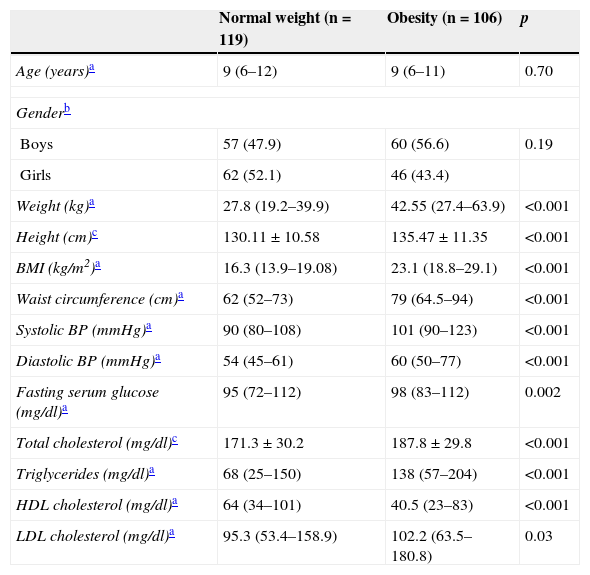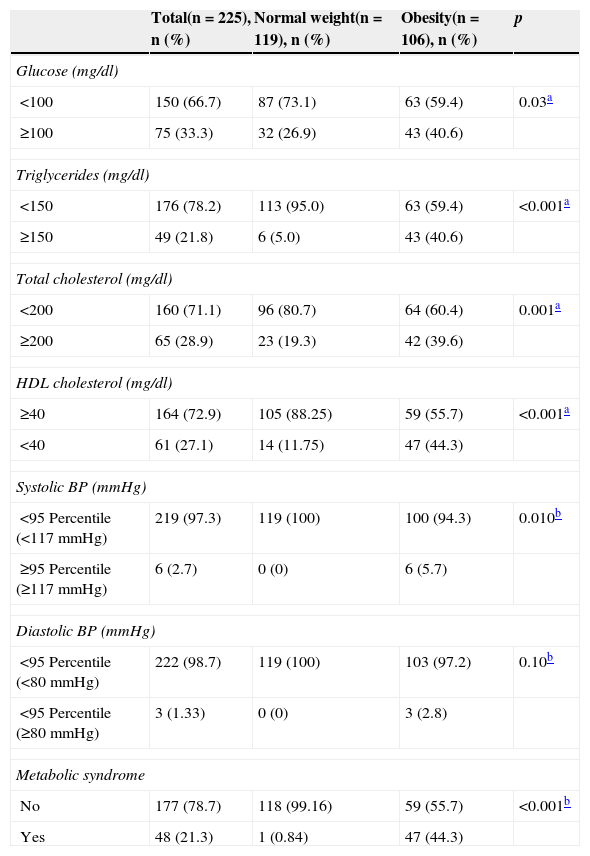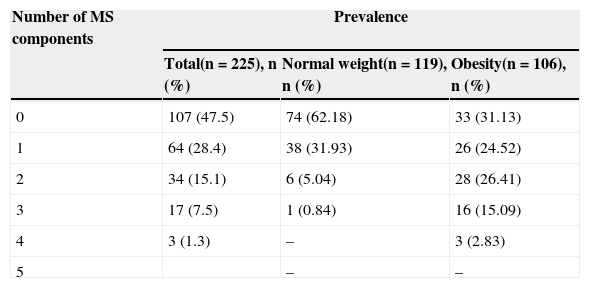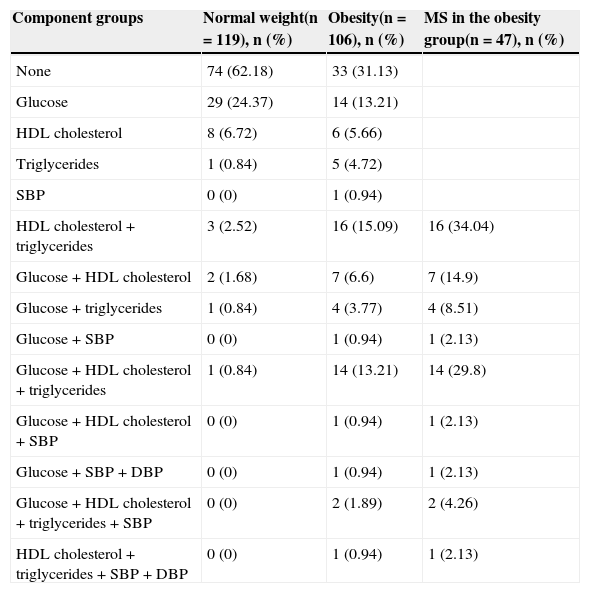Childhood obesity is considered the main risk factor for the development of metabolic syndrome (MetS) during childhood, adolescence and adulthood. This study aimed to determine the prevalence of MetS components and its main defining combinations in a sample of school children with and without obesity.
Patients and methodsA total of 225 children aged 6–12 years, 106 obese and 119 with normal weight were included. MetS was defined by the presence of 3 or more of the following: obesity as a body mass index≥95th percentile, fasting glucose≥100mg/dl, triglycerides≥150mg/dl, high density lipoproteins cholesterol (HDL-c)<40mg/dl and systolic and diastolic blood pressure≥95th percentile.
ResultsWe found MetS components in both groups. Most frequent abnormalities in the obese group included increased levels of HDL-c, triglycerides, fasting glucose and total cholesterol, while increased levels of glucose and total cholesterol, and lower HDL-c levels predominated in the normal weight group. The prevalence of MetS in the obese group was 44.3% and, in normal weight children, it was 0.84%. The 3 main components that defined the MetS in the obese group were obesity/triglycerides/HDL-c (34.0%), obesity/glucose/triglycerides/HDL-c (29.8%) and obesity/glucose/HDL-c (14.9%), while the only combination observed in the normal weight group was glucose/HDL-c/triglycerides.
ConclusionA percentage of 44.3 of obese school children had MetS, and dyslipidemia showed to be strong determinants of MetS. Although the prevalence of MetS was low in children with normal weight, one third of them showed one of the components of MetS.
La obesidad infantil es el principal factor de riesgo para el desarrollo de síndrome metabólico (SM) durante la infancia, adolescencia y vida adulta. El objetivo de este estudio fue determinar la prevalencia de los componentes del SM, y de las principales combinaciones que lo definen, en una muestra de niños escolares con y sin obesidad.
Pacientes y métodosUn total de 225 niños con edades entre 6 y 12 años, 106 con obesidad y 119 con peso normal, fueron incluidos. El SM fue definido por la presencia de 3 o más de los siguientes componentes: índice de masa corporal≥percentil 95, glucosa en ayunos≥100mg/dl, triglicéridos≥150mg/dl, colesterol unido a high density lipoproteins (HDL, «lipoproteínas de alta densidad»)<40mg/dl, presión arterial sistólica y diastólica≥percentil 95.
ResultadosEn ambos grupos analizados se encontraron componentes del SM. En el grupo con obesidad, el colesterol HDL, los triglicéridos, la glucosa en ayunos y el colesterol total fueron las alteraciones más frecuentes; en los de peso normal predominó el incremento en los valores de glucosa, colesterol total y disminución de colesterol HDL. La prevalencia de SM en niños con obesidad fue del 44,3%, y en niños de peso normal, del 0,84%. Las 3 principales combinaciones que definieron el SM en niños obesos fueron: obesidad/triglicéridos/colesterol HDL (34,0%); obesidad/glucosa/triglicéridos/colesterol HDL (29,8%) y obesidad/glucosa/colesterol HDL (14,9%); en el grupo con peso normal: glucosa/colesterol HDL/triglicéridos.
ConclusiónEl 44,3% de los niños escolares con obesidad presentaron SM; las dislipidemias mostraron ser fuertes determinantes del SM. Aunque en los niños con normopeso la prevalencia es baja, la tercera parte presentó al menos uno de los componentes del SM.
Artículo
Comprando el artículo el PDF del mismo podrá ser descargado
Precio 19,34 €
Comprar ahora










